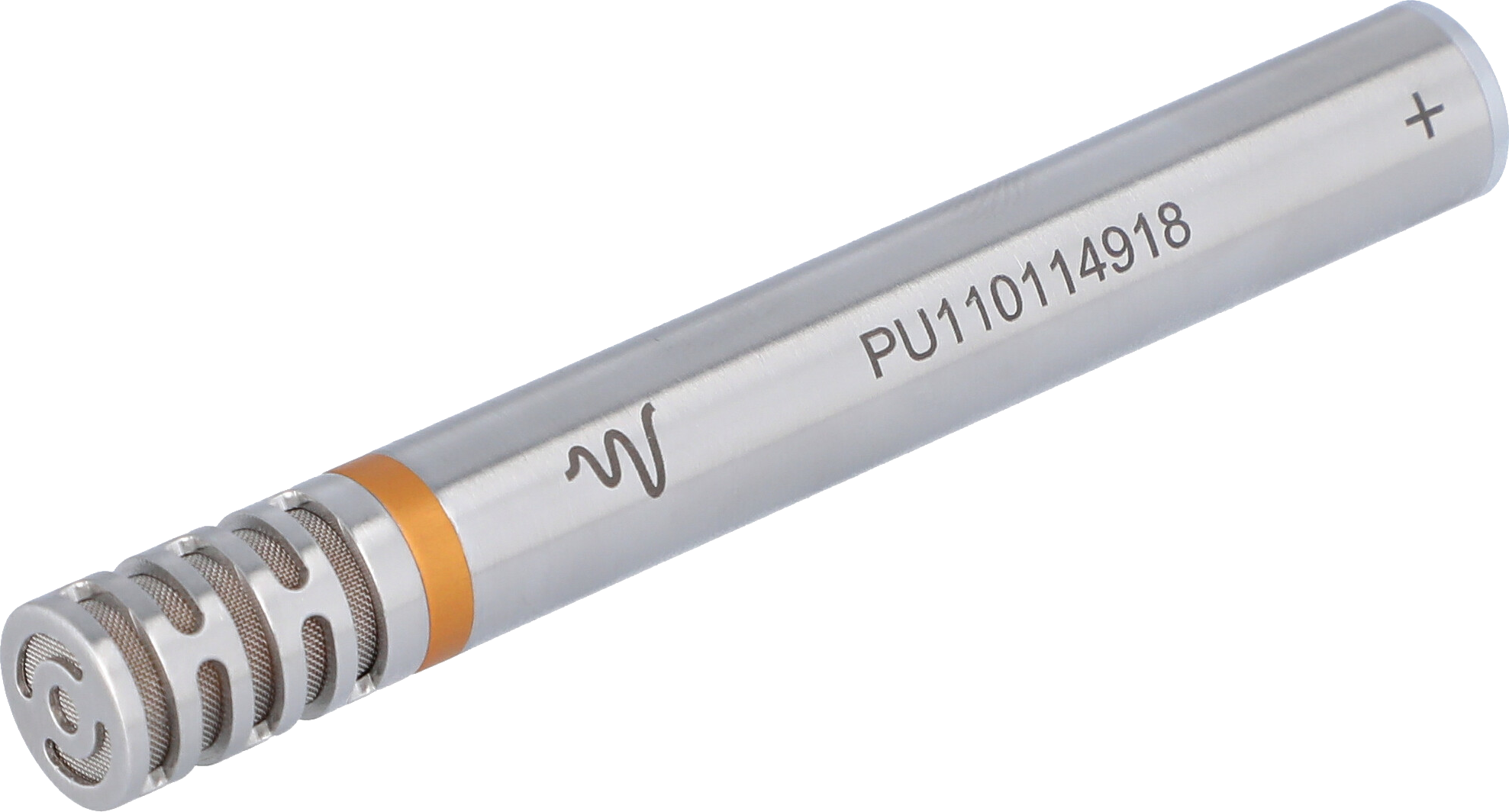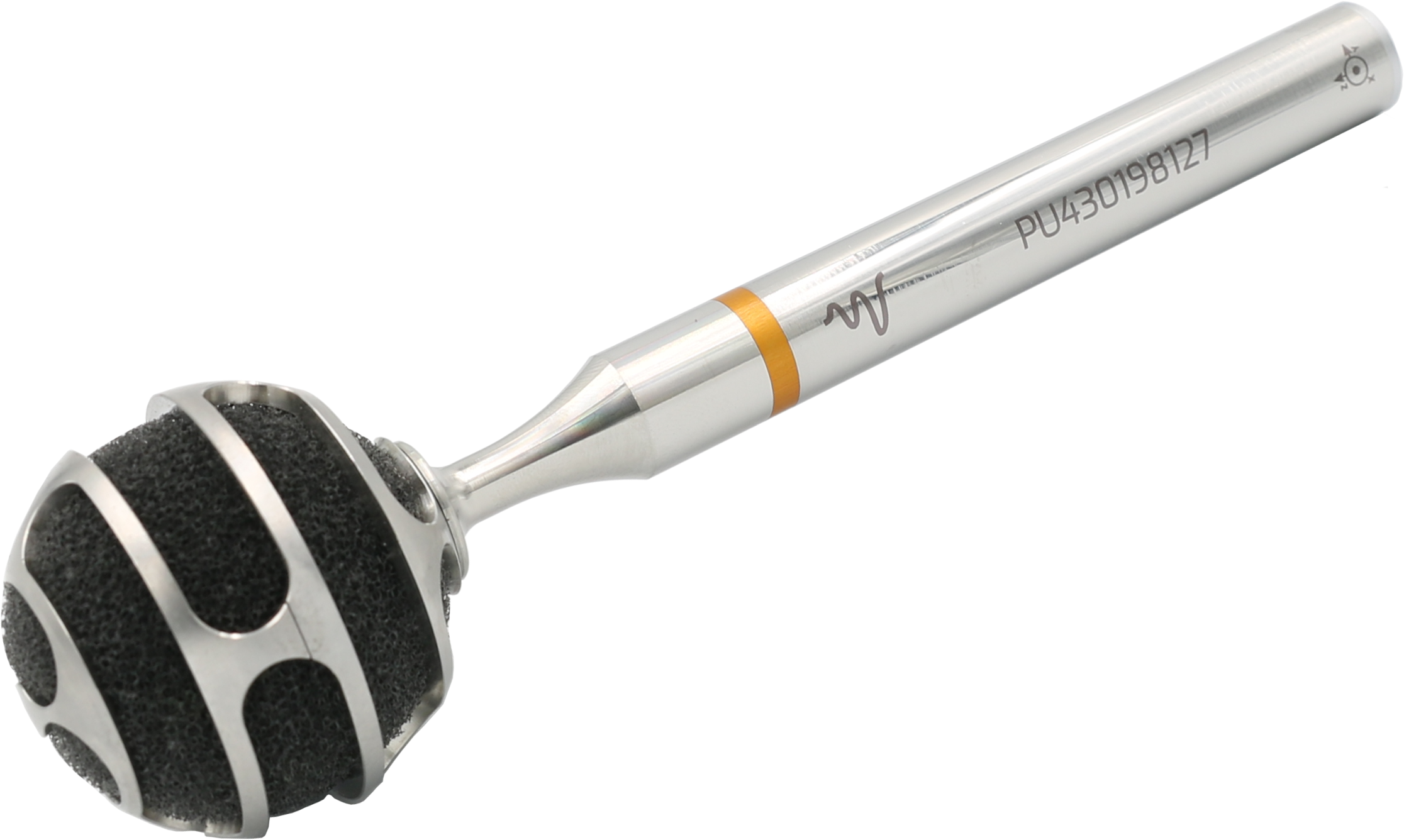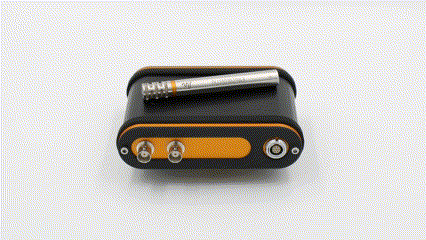#½” Sound Intensity, Sound Pressure and Particle Velocity Probe
#WA101 ONE DIMENSIONAL SOUND INTENSITY PROBE
Weles Acoustics WA101 is a general purpose sound intensity probe which relies on direct measurement of sound pressure and particle velocity. The WA101 consists of two transducers: a conventional condenser microphone and Weles particle velocity sensor. Almost full acoustic bandwidth (20 Hz to 10 kHz) can be analyzed from just one measurement - no spacers required to measure sound intensity in that bandwitdh. Detailed information regarding any sound field can be extracted without introducing any constraints on the measurement - all acoustic quantities are measured directly.
Each WA101 probe is delivered with a Weles BOX. Connection between the probe and the BOX is established with a 7-pin LEMO cable. The BOX is designed to provide power to all sensing elements built into the probe. Furthermore, the Weles BOX acts as an interface between any data acquisition system that is meant to process analog signals provided by the probe. For type WA101 two signals are provided over two BNC connectors: sound pressure and particle velocity.
#AVAILABLE CONFIGURATIONS:
- WA101H - PU Sound Intensity probe with live playback
- WELES BOX X - Weles BOX X is an integrated solution for PU Probe arrays
#KEY APPLICATIONS:
- Sound source localization and ranking – highest performance, spatial resolution and accuracy is achieved with near-field particle velocity measurement
- Particle velocity mapping
- Sound intensity mapping
- Sound power measurement
- Sound pressure measurement
- Quick troubleshooting – listen to particle velocity
#SPECIFICATIONS
| Parameter | Particle Velocity | Sound Pressure | Sound Intensity |
|---|---|---|---|
| Frequency range (±2 dB) | 20 Hz to 20 kHz | 20Hz to 20 kHz | 20Hz to 10 kHz |
| Total self-noise (20Hz - 10 kHz) | 46 dB (A) | 30 dB (A) | 46 dB (A) |
| Dynamic range upper limit (<3% THD) | 136 dB SVL | 136 dB SPL | 136 dB SIL |
| Directivity | Bi-directional | Omnidirectional | Bi-directional |
| Output Voltage Swing | 10 Vp | 10 Vp | - |
| Temperature range, operation | -20 to 85 oC | -20 to 85 oC | -20 to 85 oC |
| Temperature range, storage | -40 to 85 oC | -40 to 85 oC | -40 to 85 oC |
| Temperature coef. @250 Hz | -0.0517 dB/oC | -0.0235 dB/oC | -0.0517 dB/oC |
| Static pressure coef. @250 Hz | < 0.5 dB/kPa | < 0.5 dB/kPa | < 0.5 dB/kPa |
| Humidity coef. @250 Hz | 0.06 dB/%RH | 0.05 dB/%RH | 0.06 dB/%RH |
| Maximum DC airflow | 1 m/s | ||
| Connector type | Lemo 7p EGG-1B-307 | ||
| Weight | 38g (WA101 Probe)/365g (Weles BOX WA101) | ||
| Dimensions | 101.6/12.7 Length/Diameter | ||
| CE/RoHS compliant | Yes/Yes | ||
#TYPICAL FREQUENCY RESPONSE – PARTICLE VELOCITY SENSOR:
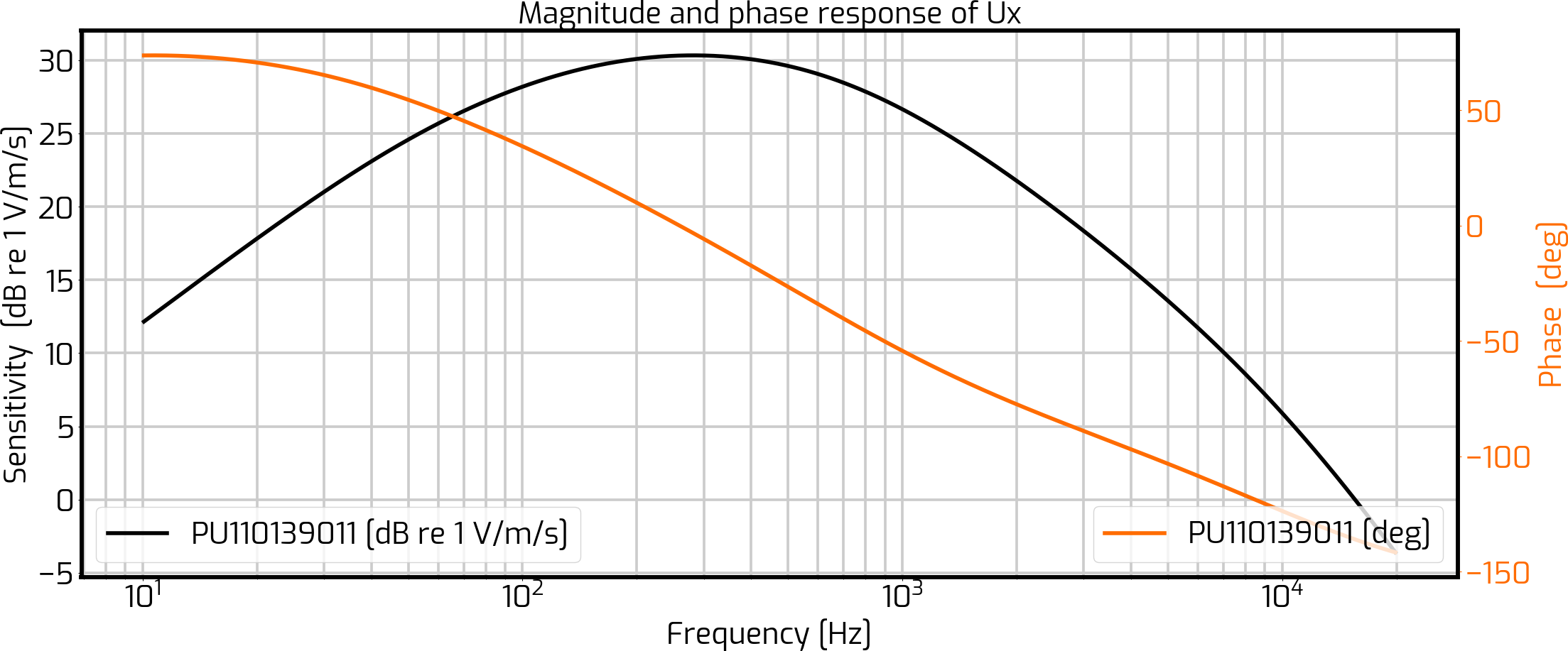
#TYPICAL FREQUENCY RESPONSE – SOUND PRESSURE MICROPHONE:
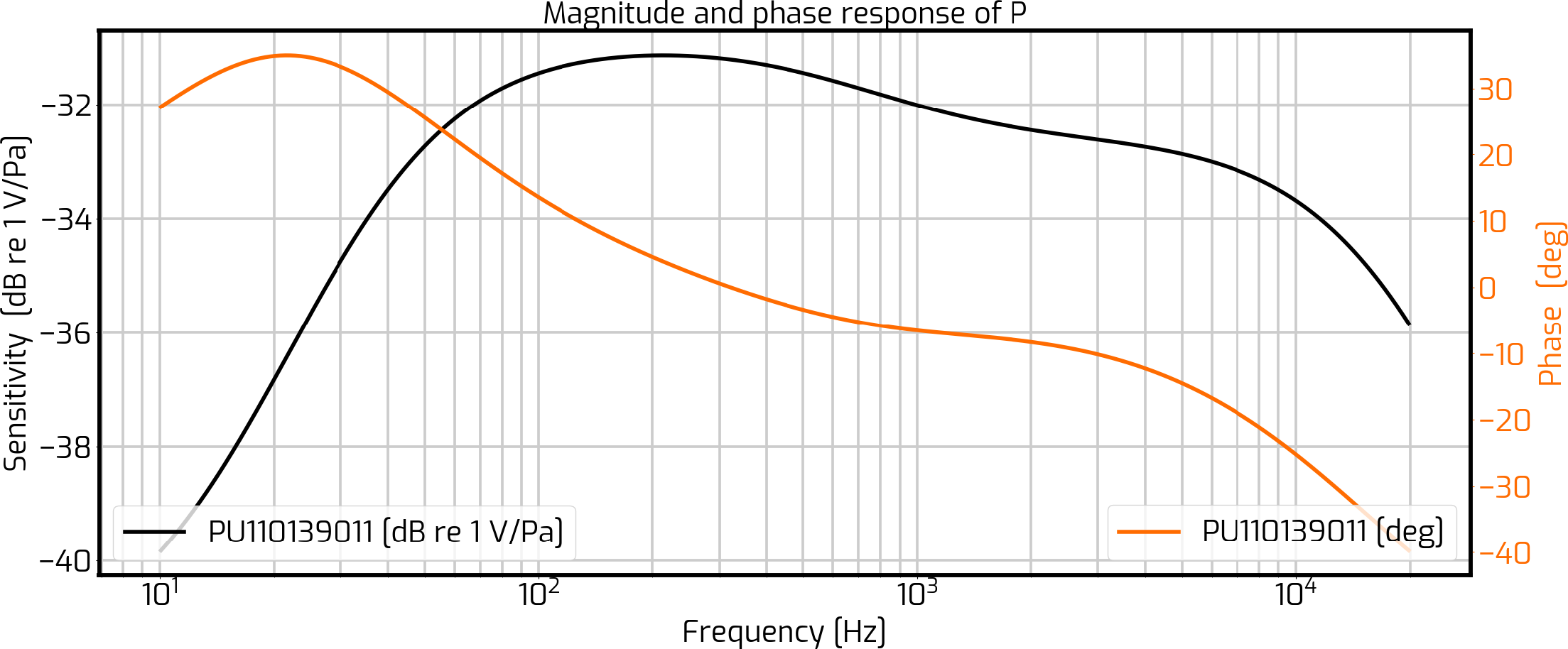
#TYPICAL SELF NOISE – SOUND PRESSURE MICROPHONE/PARTICLE VELOCITY SENSOR:
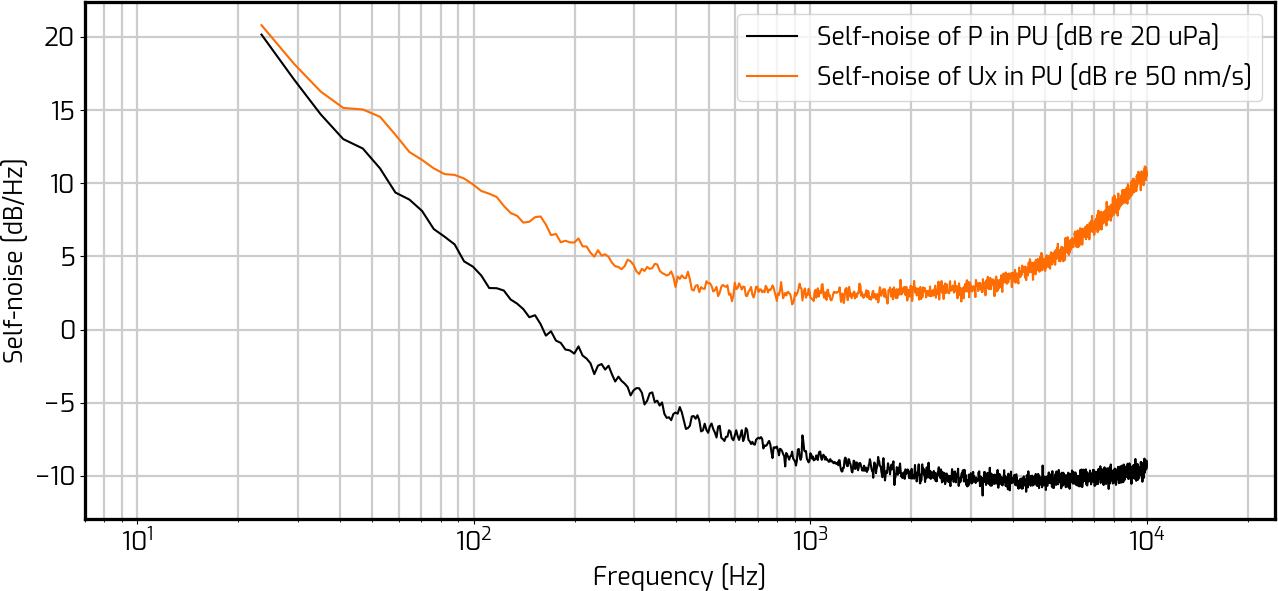
#TECHNOLOGY
Sound intensity is defined as the product of sound pressure and particle velocity. The WA101 sound intensity probe consists of two acoustic transducers: sound pressure microphone and Weles particle velocity sensor. Both quantities are measured directly, thus allowing to establish the sound intensity in the entire frequency range covered by WA101 probe. No spacers are required in order to measure sound intensity. The entire acoustic bandwidth can be analyzed with just one measurement. However, no standards yet exist for measuring sound intensity with PU probes.
Weles Acoustics designs and manufactures particle velocity transducers. Particle velocity is a physical quantity that together with sound
pressure fully characterizes any sound field. Intrinsic characteristics of particle velocity physics coupled with distinctive features of
the Weles sensor make it a unique tool for sound source localization. 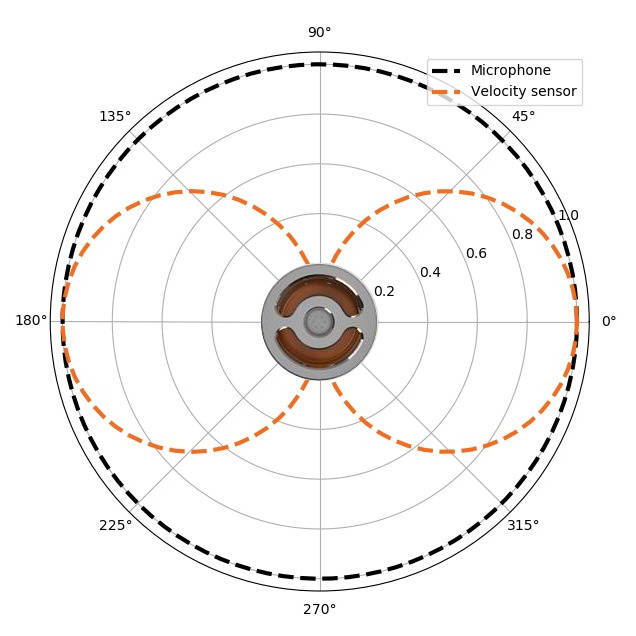 Working principle of the particle velocity sensor is similar to a hot wire anemometer. The
sensor consists of several thin platinum strings. These strings are heated to a near incandescent temperature. Passing sound waves alter
the temperature, and in turn the electrical resistance of the heated strings. The resulting voltage difference is proportional to the
acoustic particle velocity.
Working principle of the particle velocity sensor is similar to a hot wire anemometer. The
sensor consists of several thin platinum strings. These strings are heated to a near incandescent temperature. Passing sound waves alter
the temperature, and in turn the electrical resistance of the heated strings. The resulting voltage difference is proportional to the
acoustic particle velocity.
The Weles particle velocity sensor is directional. Its polar pattern resembles a figure-of-eight. It is a bi-directional transducer. Thanks to this trait and the nature of particle velocity, the transducer is a powerful diagnostics tool for any noise or vibration issues – even in the presence of high levels of background noise.
#DESIGN
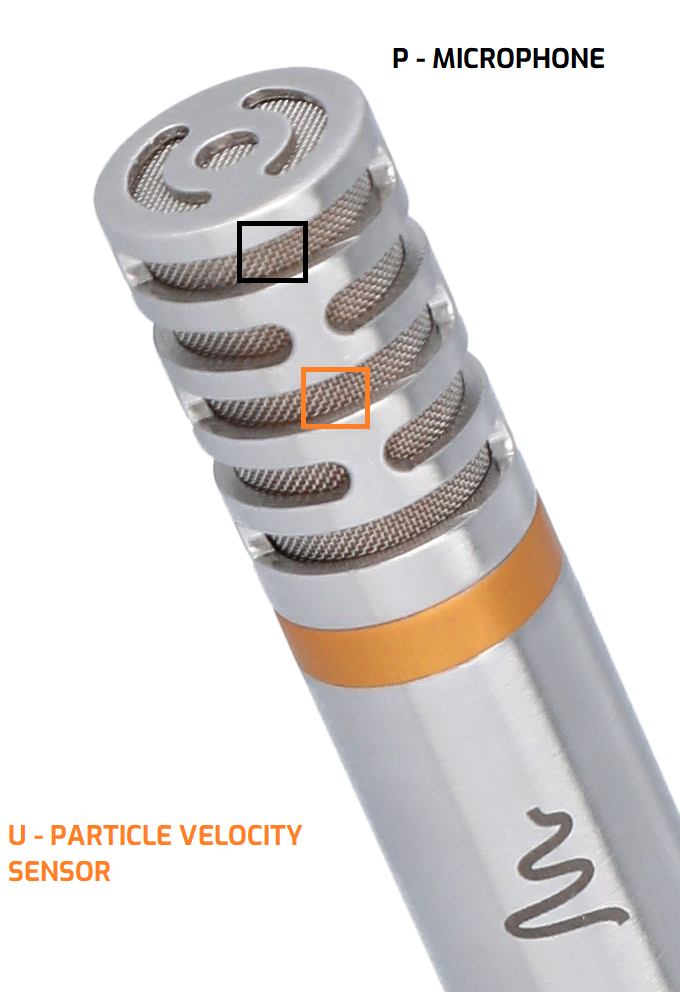 The
casing of WA101 sound intensity probe is built out of high quality stainless steel. The head of the probe was engineered to provide maximum
acoustic transparency while maintaining protection for both sensing elements from particles of dust, sand or oil. The robust and durable
housing encloses a 3D printed mechanical sound amplifier that is built around the Weles particle velocity sensor. The mechanical amplifier
is covered with a thin metal mesh. The goal of the mesh is to decrease the impact of DC airflow on particle velocity measurements.
The
casing of WA101 sound intensity probe is built out of high quality stainless steel. The head of the probe was engineered to provide maximum
acoustic transparency while maintaining protection for both sensing elements from particles of dust, sand or oil. The robust and durable
housing encloses a 3D printed mechanical sound amplifier that is built around the Weles particle velocity sensor. The mechanical amplifier
is covered with a thin metal mesh. The goal of the mesh is to decrease the impact of DC airflow on particle velocity measurements.
The mechanical amplifier is designed to increase the signal-to-noise ratio of the velocity transducer, as well as provide a mounting point for the electret sound pressure microphone. Thanks to this unique architecture, sound intensity is measured almost exactly at the same point. The distance separating both sensing elements is smaller than 8mm making the WA101 a very compact and capable solution.
WA101 probe is built, assembled and tested by Weles Acoustics. Each probe is calibrated and mechanically tested to withstand minor shocks and excessive vibration – This PU sound intensity probe is built to endure.
#SYSTEM COMPONENTS:
The WA101 Sound Intensity probe comprises the following items:
- WA101 PU Sound Intensity probe
- Weles BOX WA101
- 7 pin male LEMO to 7 pin male LEMO cable
- 5V Power supply
- USB Power cord
- Protective case
- Calibration certificate
Weles Acoustics reserves the right to change specifications without notice.
WA101 PU Probe - Optional hardware
